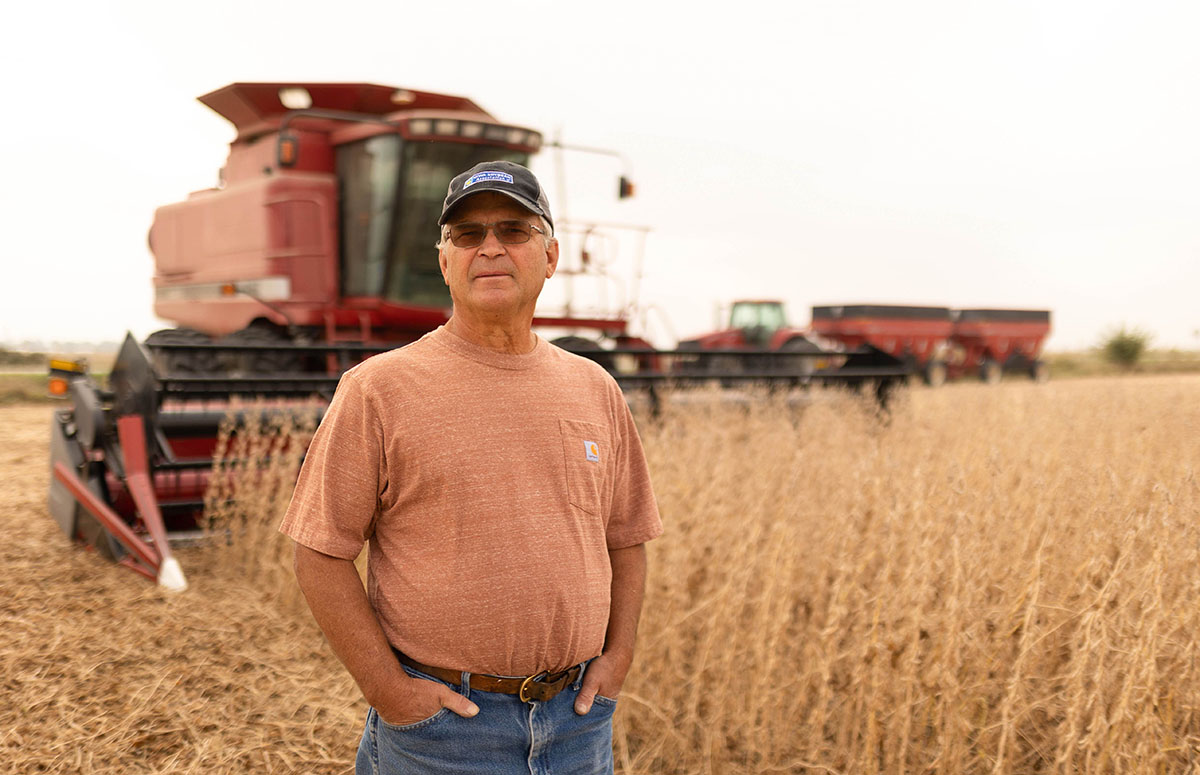
ISA President Tom Adam stands on his farm near Harper, Iowa, where his 2025 harvest continues amid ongoing trade uncertainty. (Photo: Iowa Soybean Association / Joclyn Bushman)
Act Now or Lose Ground: Urgent Action Needed to Keep U.S. Soybean Farmers Competitive
October 2, 2025
Commentary on behalf of Iowa Soybean Association President Tom Adam:
Today marks the six-month anniversary of Trade Liberation Day. Milestones are often worthy of celebration, but here in Harper, Iowa, where I’ve farmed for more than 40 years, there’s little cause for cheer.
The mood in rural Iowa—and across much of farm country—is one of anxiousness and frustration. Normally, those feelings are tied to weather delays that slow harvest.
But not this year. Harvest conditions have been nearly ideal, and crops are coming out of the field at a record pace. No, what has farmers and the businesses that support us on edge is not the weather but trade policy that's severely straining relationships with key markets for the crops we produce.
Soybeans tell the story. Historically, half of the U.S. soybean crop is exported. This year, Iowa farmers will harvest nearly 9.3 million acres of soybeans, with production totaling more than 550 million bushels. This crop will need to find a home.
While total U.S. soybean acreage and production fluctuate annually, the trendlines for both have steadily risen to keep pace with growing global demand. Key customers, including Mexico, Canada, the European Union, southeast Asia and China, value U.S. soy because of its quality and our ability to expedite shipments.
Unfortunately, sales to these vital markets are in flux as America adopts a more protectionist approach to trade and uses tariffs as bargaining chips.
China is the best example. The country of 1.4 billion people consumes 60% of global soybean exports. Until just over a decade ago, the U.S. was the global leader in soybean exports, due in large part to being China’s preferred supplier—a market painstakingly built over the past 30 years through farmer-funded checkoff investments.
More than 75 million Americans – including many farmers – voted for President Trump in 2024. Many of his priorities – from reducing wasteful spending and cutting regulatory red tape to expanding biofuels—are widely supported in rural America.
But the administration’s trade strategy has been a bitter pill for agriculture and Iowa farmers. An Iowa State University analysis estimates that reciprocal tariffs on China and other key partners could cost Iowa’s soybean industry up to $1.5 billion, nearly one-fourth of the industry’s $5.8 billion value. Corn, pork, and ethanol are also suffering steep losses.
With strong yields and a nearly ideal harvest season underway across Iowa and large sections of rural America, grain bins will soon be filled with quality U.S. soy that needs to find a home. With time of the essence, the Iowa Soybean Association urges:
1) The administration to prioritize a trade agreement with China that immediately expedites soybean purchases. Each day that passes between now and a possible meeting later this month between President Trump and Chinese President Xi closes the window tighter on the critical sales period for U.S. soybeans (October-early February) and as farmers begin making planting intentions for 2026;
2) Congress and the administration act swiftly to provide immediate trade mitigation funding to farmers as a bridge until meaningful export agreements are reached. While not ideal, federal farm payments will enable many farmers to survive another year; and
3) The administration finalizes the Renewable Volume Obligations (RVOs) and reallocates Small Refinery Exemptions as proposed earlier this year by the Environmental Protection Agency. This strong support of homegrown energy would boost demand for soybean oil and soybean prices.
Agriculture thrives when America leads on trade. We can’t afford to let uncertainty and political maneuvering erode the markets farmers have spent decades cultivating. The crop is here. The quality is proven. The demand exists. What’s missing is the resolve to reconnect America’s farmers with a world of buyers who want to purchase our soybeans.
It’s time to get trading again.
Adam farms near Harper, Iowa, in Keokuk County. The family operation includes soybeans, corn, wheat, oats, hay and beef cattle.
###
Not funded by the soybean checkoff
The Iowa Soybean Association is Driven To Deliver market demand, production research, information and insights and regulatory action benefiting Iowa's 37,000 soybean farmers and the industry. For more information, visit iasoybeans.com.
Back